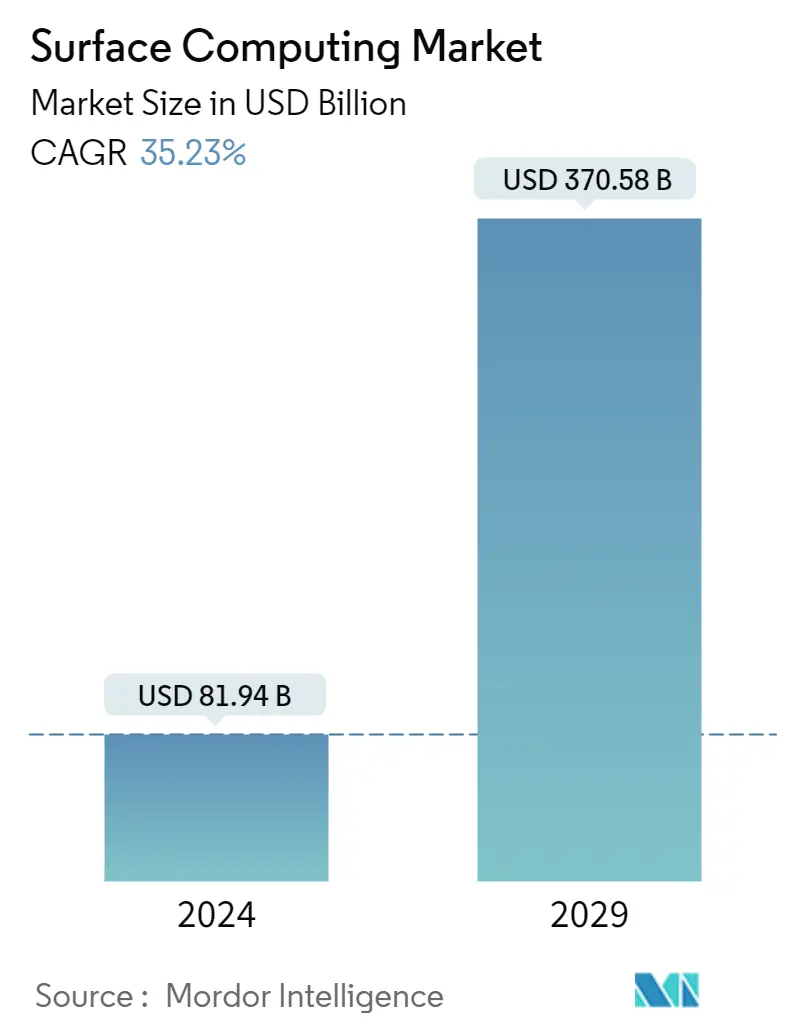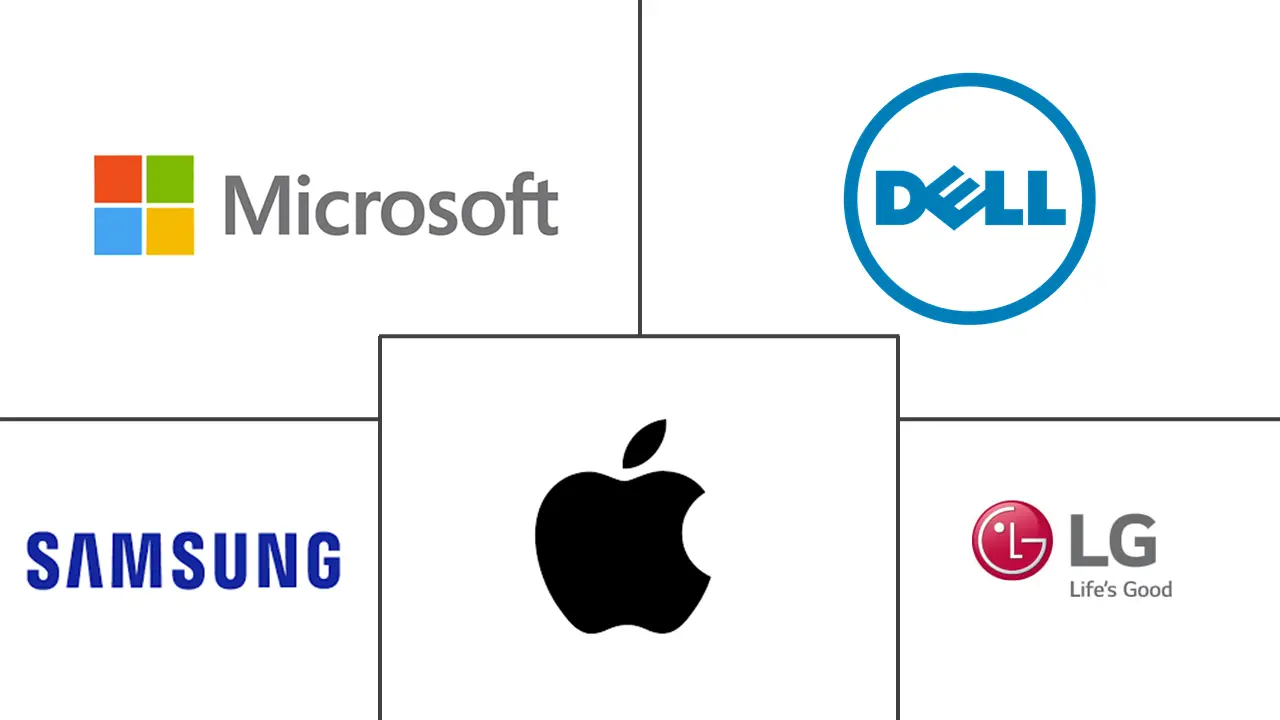Market Size of Surface Computing Industry

| Study Period | 2019 - 2029 |
| Market Size (2024) | USD 81.94 Billion |
| Market Size (2029) | USD 370.58 Billion |
| CAGR (2024 - 2029) | 35.23 % |
| Fastest Growing Market | Asia-Pacific |
| Largest Market | North America |
| Market Concentration | Medium |
Major Players
*Disclaimer: Major Players sorted in no particular order |
Surface Computing Market Analysis
The Surface Computing Market size is estimated at USD 81.94 billion in 2024, and is expected to reach USD 370.58 billion by 2029, growing at a CAGR of 35.23% during the forecast period (2024-2029).
- Surface computing is a new form of computing that allows users to work on a tabletop surface as a computer interface. Surface computing uses a specialized computer GUI as the traditional GUI is replaced by intuitive objects. Surface computing opens up a whole new category of products for users to interact with.
- Microsoft was the first company to unveil the concept of surface computing. The technology of Microsoft Surface allows non-digital objects to be used as input devices. Microsoft Surface, the first commercially available surface computer from Microsoft, is a revolutionary surface computing platform that responds to natural hand gestures and the placement of real-world objects on display.
- Using its large, 360-degree, horizontal user interface, Microsoft Surface creates a unique gathering place where multiple users can collaboratively and simultaneously interact with information and content. Furthermore, users can also interact with the machine by touching or dragging their fingertips and objects, such as paintbrushes, across the screen or by placing and moving placed objects.
- Furthermore, commercially available multitouch technology (e.g., Microsoft and SMART Technologies) enables exploration of surface computing in settings outside of the lab, such as offices, retail stores, hotels, schools, restaurants, and even hospitals, which is expected to drive the market growth during the forecast period.
- In addition, Microsoft Surface, with its unique set of features, enables companies to design innovative campaigns to attract and convert new customers as well as cross-sell products and services, drive customer loyalty, and achieve operating efficiencies.
- Interface design complexity and Multi-directional media are significant market problems. The low availability of features and the high cost of surface computers are expected to limit their adoption rate. The surface computing market has encountered a significant barrier due to the intense competition in the industry, resulting in players adopting multi-user and surface computer technology.
Surface Computing Industry Segmentation
Surface computing systems or tabletop computer systems are poised to become the future of desktops. Surface computing uses a natural user interface (NUI) to interact with users, thus enhancing the user’s experience of digital content through touch, natural gestures, and physical objects. The report provides a detailed analysis of the current and future surface computing market in developed and emerging markets by analyzing various perspectives of the market with the help of segments by type, application, and geography.
The surface computing market is segmented by type (flat display, curved display, and components (screen, camera, sensor, processor, software, projector, and other components), touch (single touch, multi-touch, multi-user, and other touches), vision (two-dimensional and three-dimensional), application (entertainment, retail, hospitality, healthcare, commercial, advertisement, automotive, education, and other applications), and geography (North America (the United States and Canada), Europe,(United Kingdom, Germany, France and Rest of Europe), Asia-Pacific (Mexico, Brazil, Argentina, And rest of Latin America), Middle East and Africa ( Saudi Arabia, UAE, South Africa and Rest of Middle-East and Africa)). The market sizes and forecasts are provided in terms of value (USD) for all the above segments.
| Type | |||||||||
| Flat Display | |||||||||
| Curved Display | |||||||||
|
| Touch | |
| Single Touch | |
| Multi-touch | |
| Multi-user | |
| Other Touches |
| Vision | |
| Two Dimensional | |
| Three Dimensional |
| Application | |
| Entertainment | |
| Retail | |
| Hospitality | |
| Healthcare | |
| Commercial | |
| Advertisement | |
| Automotive | |
| Education | |
| Other Applications |
| Geography*** | ||||||
| ||||||
| ||||||
| ||||||
| ||||||
|
Surface Computing Market Size Summary
The surface computing market is poised for significant growth, driven by the increasing adoption of intuitive and interactive computing interfaces that replace traditional GUIs with more engaging, object-based interactions. This technology, first popularized by Microsoft through its Surface platform, allows users to interact with digital content using natural hand gestures and real-world objects, creating collaborative and immersive experiences. The market is expanding beyond laboratory settings into various sectors such as retail, hospitality, and education, where multitouch technology is being utilized to enhance customer engagement and operational efficiency. Despite challenges like high costs and complex interface designs, the market is expected to thrive as businesses seek innovative ways to attract and retain customers while reducing environmental impact.
North America, particularly the United States, is a key region driving the surface computing market due to its high consumer awareness, disposable income, and concentration of technology manufacturers. The region's demand for advanced technological solutions, coupled with the growth of sectors like media and entertainment, is expected to propel market development. The competitive landscape is moderately intense, with major players like Microsoft, Dell, Apple, and Samsung leading the charge. Innovations such as virtual fitting rooms and AI-powered devices are further fueling competition and market expansion. As retailers and other sectors increasingly integrate digital experiences with physical interactions, the surface computing market is set to experience robust growth and transformation.
Surface Computing Market Size - Table of Contents
-
1. MARKET INSIGHTS
-
1.1 Market Overview
-
1.2 Industry Attractiveness – Porter's Five Forces Analysis
-
1.2.1 Threat of New Entrants
-
1.2.2 Bargaining Power of Buyers
-
1.2.3 Bargaining Power of Suppliers
-
1.2.4 Threat of Substitute Products
-
1.2.5 Intensity of Competitive Rivalry
-
-
1.3 Assessment of the Impact of COVID-19 on the Market
-
-
2. MARKET SEGMENTATION
-
2.1 Type
-
2.1.1 Flat Display
-
2.1.2 Curved Display
-
2.1.3 Components
-
2.1.3.1 Screen
-
2.1.3.2 Camera
-
2.1.3.3 Sensor
-
2.1.3.4 Processor
-
2.1.3.5 Software
-
2.1.3.6 Projector
-
2.1.3.7 Other Components
-
-
-
2.2 Touch
-
2.2.1 Single Touch
-
2.2.2 Multi-touch
-
2.2.3 Multi-user
-
2.2.4 Other Touches
-
-
2.3 Vision
-
2.3.1 Two Dimensional
-
2.3.2 Three Dimensional
-
-
2.4 Application
-
2.4.1 Entertainment
-
2.4.2 Retail
-
2.4.3 Hospitality
-
2.4.4 Healthcare
-
2.4.5 Commercial
-
2.4.6 Advertisement
-
2.4.7 Automotive
-
2.4.8 Education
-
2.4.9 Other Applications
-
-
2.5 Geography***
-
2.5.1 North America
-
2.5.1.1 United States
-
2.5.1.2 Canada
-
-
2.5.2 Europe
-
2.5.2.1 United Kingdom
-
2.5.2.2 Germany
-
2.5.2.3 France
-
-
2.5.3 Asia
-
2.5.3.1 China
-
2.5.3.2 Japan
-
2.5.3.3 India
-
2.5.3.4 Australia and New Zealand
-
-
2.5.4 Latin America
-
2.5.4.1 Mexico
-
2.5.4.2 Brazil
-
2.5.4.3 Argentina
-
-
2.5.5 Middle East and Africa
-
2.5.5.1 Saudi Arabia
-
2.5.5.2 United Arab Emirates
-
2.5.5.3 South Africa
-
-
-
Surface Computing Market Size FAQs
How big is the Surface Computing Market?
The Surface Computing Market size is expected to reach USD 81.94 billion in 2024 and grow at a CAGR of 35.23% to reach USD 370.58 billion by 2029.
What is the current Surface Computing Market size?
In 2024, the Surface Computing Market size is expected to reach USD 81.94 billion.

